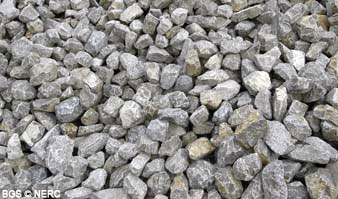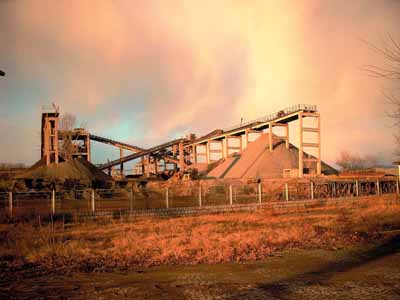Aggregate
Contents |
[edit] Introduction
Aggregate is the term given to material frequently used in construction as a means of stabilising and reinforcement. Aggregates are widely used in drainage applications and as base material under foundations and roads. In the 10 years ending in 2010, 2.5 billion tonnes of aggregates were consumed by the UK. These aggregates were supplied from various sources:
[edit] Land based
The largest source is from quarrying of the land for sand and gravel, or for rock suitable for crushing (mainly limestone, sandstone, and igneous rock, but also some unusually hard occurrences of chalk, ironstone, slate, etc.).
[edit] Marine
Sand and gravel is dredged from the seabed and is a regionally significant source.
[edit] Recycled and by-products
A wide variety of construction wastes and industrial by-products make a major contribution to supply. These include construction, demolition and excavation wastes, slags and ashes, and mineral wastes;
[edit] Specialist
Small amounts of certain lightweight and high density aggregates are manufactured for specialist purposes.
[edit] Imported
The balance of supply consists of imported material (mainly as crushed rock or value-added products) principally from elsewhere in the UK and Norway.
The industry takes its environmental impact very seriously and as a result the UK industry has become a world leader in terms of the quality of its land restoration work. More than 700 Sites of Special Scientific Interest have their origins in mineral operations. In 2009, the industry planted 313,000 trees and 14.4 km of hedgerows. By 2009, there were 283 liaison groups in aggregate quarries.
[edit] Uses
As a basic raw material aggregates can be put to many uses, although certain tasks may require a specific type of aggregate. A large proportion of aggregate is used to manufacture concrete, as well as the cement that is used in the concrete.
Aggregates are used in construction to provide drainage, fill voids, protect pipes, and to provide hard surfaces.
Aggregates are not just used for construction. A vast array of other products, many of which are taken for granted, are manufactured using materials derived from quarrying. These include: paper, glass, cosmetics and toothpaste to name but a few. Aggregates are also used in agriculture, food manufacture, and water and sewage purification. Water will percolate through a trench filled with aggregate more quickly than it will through the surrounding soil, thus enabling an area to be drained of surface water. This is frequently used alongside roads in order to disperse water collected from the asphalt surfacing.
Voids created around the foundations of buildings during construction are filled with aggregate because it is easier to compact than the original soil that was removed, resulting in a more solid finish that will support the structure. Aggregates generally are not affected by the weather as much as soils, particularly clay soils, and will not suffer from shrinkage cracking during dry spells.
Pipes laid to convey treated water, or as conduits for cables, need to be protected from sharp objects in the ground and are therefore laid on, and surrounded by, fine aggregate before trenches are backfilled.
Unpaved roads and parking areas are covered in a surface layer of aggregate to provide a more solid surface for vehicles, from bicycles to lorries. This prevents the vehicles from sinking into the soil, particularly during wet weather.
[edit] Concrete
Concrete is a mixture of aggregates, cement and water. The purpose of the aggregates within this mixture is to provide a rigid skeletal structure and to reduce the space occupied by the cement paste. Both coarse aggregates (particle sizes of 20 mm to 4 mm) and fine aggregates (particle sizes less than 4 mm) are required but the proportions of different sizes of coarse aggregate will vary depending on the particular mix required for each individual end use.
The smaller the aggregate size the greater its surface area and the more cement will be required to bind it all together, resulting in a higher cost. However, in general terms, the greater the quantity of cement used the stronger the concrete will be. Therefore, a balance needs to be made between the strength requirements of the end use and the price willing to be paid.
[edit] Asphalt and roadstone
This category includes not just roads, but also pavements, airport runways, school playgrounds, car parks, most footpaths or cycleways, and other similar structures. Although each type of structure will require some variation in the material, it is useful to look at the basic structure of roads because they represent the bulk of the aggregate use in this category.
The subgrade represents the natural soil, which will be compacted before the road construction starts. The capping layer is an optional layer, used when the local soils require extra strength, and it is not coated with bitumen. The sub-base is the main uncoated roadstone layer and its role is to give strength and act as a solid platform for the layers above.
The binder course (previously two layers known as the base course and roadbase) and surface course (previously known as wearing course) are commonly called 'asphalt' or 'tarmacadam'. They consist of coarse aggregates, with particle sizes typically between 2 mm to 28 mm, and fine aggregates, with particle sizes of less than 2 mm, mixed with a bitumen binder and occasionally some additional filler if required. The exact sizes required for the coarse aggregates will depend on the particular use and the asphalt recipe specified.
[edit] Railway ballast
A fully loaded train weighs a considerable amount (> 2 000 tonnes), added to this is the weight of the track itself and the sleepers it rests on. A very tough aggregate is needed to support this weight and distribute the load of a passing train to avoid serious damage to the ground, or other structures, underneath. Similarly the railway track and sleepers must be held in place firmly and not move as a train passes along them.
Railway ballast generally consists of a tough igneous rock, such as granite, with large (40-50 mm size) angular pieces that lock together. Because of the way igneous rock is formed it is highly resistant to pressure and does not break easily.
[edit] Non-aggregate uses of sand, gravel and crushed rock materials
[edit] Cement
Cement is a substance manufactured from limestone and shale, with other minor additives, at temperatures in excess of 1,200ºC. It has unique properties - as a powder it is loose and friable, but mixed with water it hydrates into a paste and then as it dries it sets hard and binds all the surrounding particles together.
[edit] Agriculture
Lime is taken up by plants (either crops or grass) and trees but is also naturally lost from soils through leaching by rainwater and the use of fertilisers. This can result in an increase in acidity, loss of fertility in the soil and sometimes an adverse affect on soil structure.
To redress the balance, 'agricultural lime' is applied to fields to maintain the necessary growing conditions for crops or grassland. Lime can be simply ground limestone or dolomite (which also contains magnesium) or burnt limestone, (or burnt dolomite) where the rock is heated in a kiln.
[edit] Glass
Glass is made from melting silica sand at a high temperature, in the presence of sodium as a flux. The molten glass, at approximately 1,000ºC is poured continuously from a furnace onto a shallow bath of molten tin, where it spreads out evenly. It is then cooled quickly before crystallisation can occur.
[edit] Industrial and other uses
Limestone is used as a flux in the extraction of iron from iron ore. Iron is extracted from ore by heating in a furnace. Limestone is added so that the silicon in the ore forms a calcium silicate (with the calcium carbonate that is limestone) otherwise it would form an iron silicate and thus reduce the quantity of metallic iron produced. The calcium silicate, together with other impurities, forms the 'slag' and this substance can be used as a lightweight secondary aggregate.
Sand, usually silica sand, is used to make moulds in a foundry. These are the hollow containers into which molten metal is poured to produce a casting of a particular shape. The exact type of sand used depends on the particular metal or alloy that is to be cast, but it usually contains clay and/or some other material to bind it together.
The burning of coal at power stations produces sulphur dioxide, one of the main gases that causes acid rain. Rather than simply emit this gas along with their other flue gases, most coal fired power stations today use limestone in a process known as 'flue-gas desulphurisation'.
Limestone is finely crushed and mixed with water to form a slurry. It is then sprayed into the absorber tower of the power station where a chemical process converts the limestone and sulphur into gypsum. This 'artificial' gypsum is then recovered and sold for the manufacture of plasterboard.
Limestone, or calcium carbonate, also has many other uses. Ground to a fine powder it is used as a whitening agent or filler in paper, adhesives, paint, plastics, PVC, toothpaste, medical tablets and cleaning products. It is also used to provide additional calcium in vitamin and mineral supplements, flour and animal feed.
[edit] Specialist aggregates
Specialist aggregates are required for use in certain demanding applications; notably where lightweight members are required in constructions or where heavy, high density materials are required.
[edit] Light weight aggregate
Light weight aggregates (LWA) are required for situations where concrete is required that imposes low loads on structural elements of constructions. The aggregates therefore need to have low density and weight, achieved by using porous materials, but adequate strength.
A variety of materials can be pelletised (formed into pellets) and heated causing them to harden and expand. These include clay, shale and slate, sludge (e.g. from sewerage works), fine grained sediments dredged from the sea or rivers, and pulverised fuel ash.
Other materials that can be used are natural volcanic materials that are full of gas cavities including pumice and scoriae ('natural cinders'). The volcanic materials do not occur in the UK but can be imported, particularly from Italy.
[edit] High density aggregate
High density aggregates are required for manufacture of concrete that is capable of, for instance, attenuating radiation and thus be suitable for shielding nuclear installations and medical facilities such as radio-therapy treatment rooms.
Aggregates are a most critical and important component of high density concrete and are principally crushed minerals containing relatively heavy elements, in combination with various additives but can also include scrap steel or certain ceramics.
The relevant minerals include crushed hematite and magnetite (both iron oxides), limonite (iron hydroxide) ilmenite (iron titanium oxide) and barite (barytes - barium sulphate). Other additives can include serpentinite (hydrous calcium magnesium silicate) and borax (sodium borate).
This article was authored by the Mineral Industry Research Organisation.
--Mineral Industry Research Organisation
[edit] Related articles on Designing Buildings Wiki
- Aggregates levy.
- Ballast.
- BREEAM Recycled aggregates.
- Bulk filling materials.
- Chert.
- Coal ash.
- Concrete masonry unit CMU.
- Construction aggregates market 2016 - 2024.
- Global construction aggregates market revenue to 2021.
- Gravel.
- Gravel v hardcore v aggregates.
- Hardcore.
- Manufacture of lightweight aggregate granules containing phase change materials.
- Material Flow Analysis: A tool for sustainable aggregate sourcing.
- Recycled aggregates.
- Sustainable aggregates.
Featured articles and news
British architecture 1919–39. Book review.
Conservation of listed prefabs in Moseley.
Energy industry calls for urgent reform.
Heritage staff wellbeing at work survey.
A five minute introduction.
50th Golden anniversary ECA Edmundson apprentice award
Showcasing the very best electrotechnical and engineering services for half a century.
Welsh government consults on HRBs and reg changes
Seeking feedback on a new regulatory regime and a broad range of issues.
CIOB Client Guide (2nd edition) March 2025
Free download covering statutory dutyholder roles under the Building Safety Act and much more.
AI and automation in 3D modelling and spatial design
Can almost half of design development tasks be automated?
Minister quizzed, as responsibility transfers to MHCLG and BSR publishes new building control guidance.
UK environmental regulations reform 2025
Amid wider new approaches to ensure regulators and regulation support growth.
The maintenance challenge of tenements.
BSRIA Statutory Compliance Inspection Checklist
BG80/2025 now significantly updated to include requirements related to important changes in legislation.
Shortlist for the 2025 Roofscape Design Awards
Talent and innovation showcase announcement from the trussed rafter industry.
OpenUSD possibilities: Look before you leap
Being ready for the OpenUSD solutions set to transform architecture and design.
Global Asbestos Awareness Week 2025
Highlighting the continuing threat to trades persons.
Retrofit of Buildings, a CIOB Technical Publication
Now available in Arabic and Chinese as well as English.



























Comments